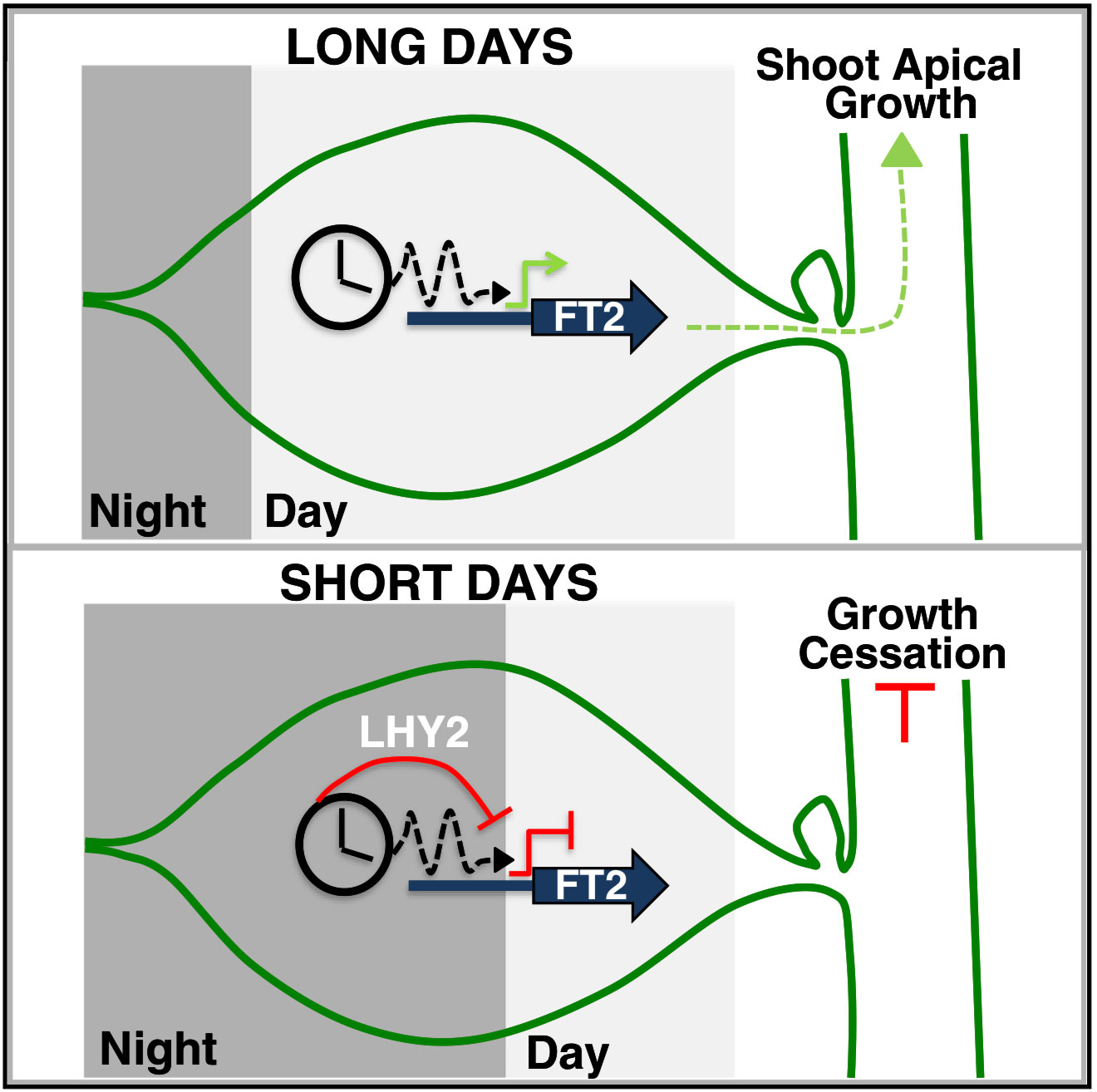博文
Current Biology:生物钟基因LHY2整合黑夜长度信息调控杨树的光周期生长
||
LHY2 Integrates Night-Length Information to Determine Timing of Poplar Photoperiodic Growth
First author: José M. Ramos-Sánchez; Affiliations: Universidad Politécnica de Madrid (马德里理工大学): Madrid, Spain
Corresponding author: Mariano Perales
Day length is a key indicator of seasonal information that determines major patterns of behavior in plants and animals. Photoperiodism has been described in plants for about 100 years, but the underlying molecular mechanisms of day length perception and signal transduction in many systems are not well understood. In trees, photoperiod perception plays a major role in growth cessation during the autumn as well as activating the resumption of shoot growth in the spring, both processes controlled by FLOWERING LOCUS T2 (FT2) expression levels and critical for the survival of perennial plants over winter. It has been shown that the conserved role of poplar orthologs to Arabidopsis CONSTANS (CO) directly activates FT2 expression. Overexpression of poplar CO is, however, not sufficient to sustain FT2 expression under short days, pointing to the presence of an additional short-day-dependent FT2 repression pathway in poplar. We find that night length information is transmitted via the expression level of a poplar clock gene, LATE ELONGATED HYPOCOTYL 2 (LHY2), which controls FT2 expression. Repression of FT2 is a function of the night extension and LHY2 expression level. We show that LHY2 is necessary and sufficient to activate night length repressive signaling. We propose that the photoperiodic control of shoot growth in poplar involves a balance between FT2 activating and repressing pathways. Our results show that poplar relies on night length measurement to determine photoperiodism through interaction between light signaling pathways and the circadian clock.

日照长度是控制植物和动物行为模式的季节信息的主要指标。光周期现象在植物中发现已有100多年的历史,但在很多植物系统中感知日照长度以及信号转导的分子机制还不清楚。在林木中,光周期的感知在秋季植物停止生长,春季嫩枝恢复生长的过程中发挥重要作用,这两个生物学过程均由FT2基因的表达水平调控,这对于林木是否能够顺利越冬至关重要。已有的研究指出杨树中拟南芥CO的同源基因能够直接激活FT2基因的表达。然而,过表达杨树的CO基因并不足以在短日照条件下维持FT2的表达,说明杨树中存在其它依赖于短日照的FT2表达调控通路。作者发现杨树中的生物钟基因LHY2的表达水平能够传递黑夜长度信息,从而调控FT2的表达。黑夜延长其中一个功能就是能够抑制FT2基因的表达,这同样也是LHY2基因的功能之一。作者的试验显示LHY2基因是激活黑夜长度抑制信号途径的充分必要条件。本文的结果揭示了杨树通过光照信号途径与生物钟的相互作用,从而利用黑夜长度的信息来决定光周期。
通讯:Mariano Perales (http://www.cbgp.upm.es/index.php/es/?option=com_content&view=article&id=18&x=2022)
研究方向:林木季节、昼夜交替生长-休眠的调控机制。
doi: https://doi.org/10.1016/j.cub.2019.06.003
Journal: Current Biology
Published date: June 27, 2019

https://blog.sciencenet.cn/blog-3158122-1187370.html
上一篇:Plant Physiology:miR166通过SPL/NZZ调控花药内部边界的形成
下一篇:Plant Cell:玉米衰老相关基因调控网络的鉴定
全部作者的其他最新博文
- • Plant Physiology:CsMADS3促进柑果中的叶绿素降解和类胡萝卜素合成(华中农业大学)
- • Molecular Plant:LBD11-ROS反馈调节作用于拟南芥的维管形成层增殖和次生生长(浦项科技大学)
- • Science Advances:根结线虫通过调控植物的CLE3-CLV1模块,促进侵染进程(日本熊本大学)
- • Nature Communications:油菜素内酯参与植物营养生长期转变的分子机制解析(浙江农林大学)
- • Current Biology:光合作用产生的蔗糖驱动侧根“生物钟”(德国弗莱堡大学)
- • PNAS:花同源异型基因在叶中被抑制、花中被激活的分子机制(南卡罗来纳大学)
全部精选博文导读
相关博文
- • Tables of Distinctions and Boundaries Among 4 Spaces(初学者版)
- • Distinctions and Boundaries Among 4 Spaces(初学者版)
- • Mathematical Differences Among 4 Spaces(初学者版)
- • Differences Among 4 Spaces in the DIKWP Mathematics(初学者版)
- • Capabilities of Conceptual Space, Semantic Space, Cogn(初学者版)
- • Mutual Expressions Between 4 Spaces(初学者版)